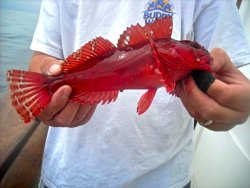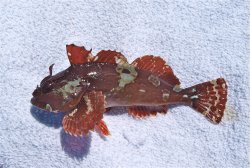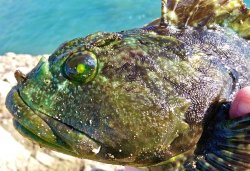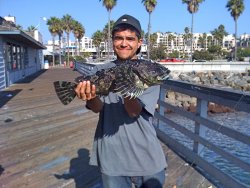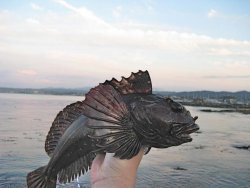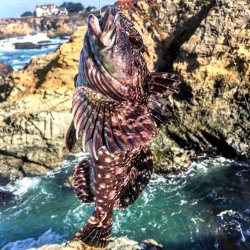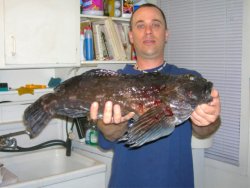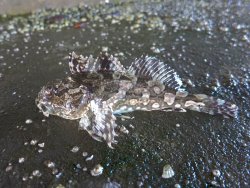Sculpins—Family Cottidae
Cabezon
Cabezon
Species: Scorpaenichthys marmoratus (Ayres, 1854); from the Greek words scorpaena (a related species) and ichthys (fish), and the Latin word marmoratus (marbled).
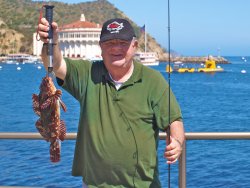
Cabezon from the Cabrillo Mole in Avalon by KJ
Alternate Names: Commonly called bullhead; also marbled sculpin, cab, cabby, bull cod, blue cod, giant sculpin, giant marbled sculpin, scorpion, marble sculpin, salpa and scaleless sculpin, king of sculpin. Some “slang” names by anglers include cab driver, frog fish and handle bars. Cabezon were typically called capason or capozini in the early days of the Santa Cruz Municipal Wharf where one nickname was “St. Patrick’s Fish” for their greenish coloring. Called scorpion or biggy-head by 19th century Italian fishermen; sea robin by some early SoCal fishermen.
Identification: They have a very large head with a broad bony support from the eye across the cheek, no scales, a cirrus (fleshy flap) on the midline of the snout, and a pair of longer cirrus just behind the eyes. The coloring is brown, bronze, reddish, or greenish above, whitish or turquoise green below, with dark and light mottling on the side. The lining of the mouth is a translucent turquoise green. The color may correlate to their sex with 90% or greater red-colored cabezon being males, 90% or greater green-colored cabezon being females. The mouth is broad with many small teeth. Juveniles are sometimes bright red.
Size: To 39 inches and 25 pounds; most caught from piers are less than two feet in length. The cabezon is the largest member of the cottid (sculpin) family. The California angling record was a fish weighing 23 Lbs. 4 oz.; it was taken near Los Angeles in 1958. The diving record is for an 18 Lbs. 6 oz. fish taken off Pedotti Ranch in Sonoma County in 1984. The IGFA World Record fish is listed at 23 Lbs 0 oz and was caught in the Juan De Fuca Strait, Washington in 1990.
Range: Punta Abreojos, (mainland), and Isla Cedros, Islas San Benitos, and Isla Natividad, central Baja, California, to Samsing Cove, near Sitka in southeastern Alaska and Icy Bay, Prince William Sound, Alaska. Common from Bahia Playa Maria, central Baja California, to Haida Gwaii, British Columbia.
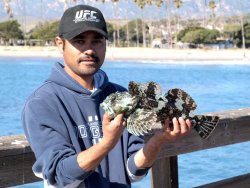
Cabezon from the Goleta Pier
Habitat: Typically found in shallow-water rocky areas, from intertidal pools to jetties, kelp beds and rocky reefs, any area with dense algal growth. Older fish tend to move to deeper water, as deep as 250 feet; recorded to a depth of 798 feet. Typically inhabits the tops of rocky ledges as contrasted with rockfish and lingcod that prefer the sheer faces of ledges. Cabezon like to sit and it doesn’t seem to matter if it’s in a hole, on the reef, or on vegetation, they sit versus actively swimming—until they see food.
Piers: Cabezon are one of the premier fish for northern California pier anglers with lesser numbers taken from southern and central California piers. Best bets: Cabrillo Pier, Goleta Pier, Monterey Coast Guard Pier, Santa Cruz Wharf, San Francisco Municipal Pier, Point Arena Pier, Trinidad Pier and Citizens Dock (Crescent City).
Shoreline: A favorite catch for rocky-shore anglers throughout California.
Boats: A prize species for boaters in central and northern California.
Bait and Tackle: Although most of the cabezon caught from piers will be fairly small fish less than two feet in length, most years also see some larger fish in the 8-12 pound category. Because of this, you should use at least medium-sized tackle; line testing at least 15 pound breaking strength and hooks around 2/0 in size. The best baits are small crabs and fresh mussels but cabezon will bite almost anything that looks like food. Their normal diet includes crabs, small lobsters, abalone, squid, octopus, small fish and fish eggs. Although they often reach good size, they can be frustrating to catch. Cabezon will often tap or mouth bait and spit it out; patience and a feel for when to set the hook is required. Also remember that cabezon like to congregate around “cabezon” holes; if you catch one, there will often be more around.
Food Value: Excellent! Cabezon offer up firm textured, mild-flavored fillets that have a somewhat delicate, sweet taste similar to crab meat. Given that crabs are one of their main foods, that shouldn’t be too surprising. Cabezon can be prepared in almost any manner—fried, baked, grilled, or steamed. Although few fish are better eating, anglers should not eat the roe (eggs) of cabezon—the eggs are poisonous and can make a person violently ill. Don't worry if the flesh is blue colored, this is a common occurrence and the flesh will turn white when cooked.
Comments: A “lie-in-wait” predator. Their coloring lets them blend in with the surroundings where they lie motionless. When food passes by they use their large, powerful pectoral fins and tails to lunge after the prey engulfing it in their large mouths. In Spanish, cabezon means big headed or stubborn and it well describes both their looks and temperament. Cabezon can live to about 20 years of age and I imagine an old cabezon would be a real grouch.
An interesting name—“J. L. Schoebech landed a caponzini weighing fifteen pounds, which the crowd of fishermen nicknamed St. Patrick’s fish, from its green coloring and deep greenish bulging eyes, which are enormous in size, with a big circle of yellow encasing the entire eyeball. The head and mouth are immense. When held up to the sun the green and yellow with the white mouth present a striking combination of colors.”—Santa Cruz Evening News, March 17, 1919

